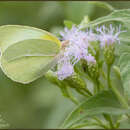pt-BR
nomes no trilho de navegação


Kricogonia lyside és una espècie de lepidòpter ditrisi de la família Pieridae. Les seves larves s'alimenten de les fulles d'arbres dels gèneres Porleria i Guaiacum. S'han registrat notoris esdeveniments de moviments massius o migracions a Mèxic i el sud dels Estats Units. A les illes del Carib i el nord d'Amèrica del Sud la seva única planta hostatjadora és Guaiacum officinale.
Kricogonia lyside, the lyside sulphur or guayacan sulphur,[2] is a North American, Caribbean, and South American butterfly in the family Pieridae.
In seasons with heavy monsoons, this butterfly is seen in massive migrations which are frequent in Texas but more rare in the southwest. It is also an occasional resident in southern Florida.
The lyside sulphur is variable. The upperside of the wings is pale yellow, usually with a black bar on the leading edge of the hindwing and a bright yellow patch near the base of the forewing. Some individuals also have black borders along the costa and apex of the forewing. The underside of the wings varies from a greenish color to bright yellow to almost white.[3] Greener individuals have a whitish vein in the center of the hindwing and a bright yellow forewing basal patch.[4] It has a wingspan of 3.8 to 6 cm (1.5 to 2.4 in).[5]
Similar species in the lyside sulphur's range include Queen Alexandra's sulphur (Colias alexandra), the cloudless sulphur (Phoebis sennae), and the statira sulphur (Aphrissa statira).
Queen Alexandra's sulphur has more yellow on the underside of the forewing and has a whitish spot in the center of the hindwing.[6]
The cloudless sulphur is larger and is much more yellow.[6]
The statira sulphur has a more yellowish upper side and the underside of the wings is pale greenish to white with females having light pinkish markings.[3]
The lyside sulphur may be found in open, subtropical scrub.[2]
This butterfly is seen almost all year in southern Texas[2] and is seen from early July to mid-November in Arizona.[6] In Florida there have been scattered sightings from July to October.[4]
The larva is highly variable. It ranges in color from grass green to blackish green. It may have markings or may be unmarked. Marked individuals usually have dorsal and spiracular silvery stripes. It is the only caterpillar to feed on plants in the family Zygophyllaceae.[7] Apparently they feed exclusively on the leaves of three Guaiacum species: G. sanctum and G. angustifolium in Central and North America and G. officinale in South America and the Caribbean.[3][5][8] The chrysalis is a bluish-green color.[2] The lyside sulphur can grow from egg to adult in as little as 13 days. It has three or more broods per year in southern Texas.[8]
Kricogonia lyside, the lyside sulphur or guayacan sulphur, is a North American, Caribbean, and South American butterfly in the family Pieridae.
In seasons with heavy monsoons, this butterfly is seen in massive migrations which are frequent in Texas but more rare in the southwest. It is also an occasional resident in southern Florida.
La mariposa del guayacán (Kricogonia lyside) es una especie de lepidóptero ditrisio de la familia Pieridae. Sus larvas se alimentan de las hojas de árboles de los géneros Porleria y Guaiacum. Se han registrado notorios eventos de movimientos masivos o migraciones en México y el sur de los Estados Unidos. En las islas del Caribe y el norte de Sudamérica su única planta hospedera es Guaiacum officinale.
Tradicionalmente se ubica al género Kricogonia en la subfamilia Coliadinae.[1] Sin embargo la genitalia femenina muestra características morfológicas únicas dentro de los piéridos.[2] Por otro lado, todas las plantas hospederas conocidas son atípicas para la familia, y esto puede indicar una historia filogenética particular.[3]
En la literatura se encuentran hasta ocho nombres diferentes para las especies de Kricogonia (K. cabrerai, K. castalia, K. fantasia, K. lanice, K. lyside, K. terissa, K. unicolor, K. xanthophila).[4] A excepción de K. cabrerai, la cual es endémica de Cuba, todos estos nombres se consideran sinónimos de K. lyside.[5]
Esta especie ha sido reportada en Venezuela (toda la costa del Mar Caribe),[6] Colombia (Península Guajira),[7] Costa Rica (Provincia de Guanacaste),[8] México, Estados Unidos, Cuba, República Dominicana y Jamaica, Curaçao y Aruba.[9] [10] y recientemente se encontró en una población en Honduras (Arenal (Honduras), Yoro)
Se han constatado eventos migratorios importantes en Norte América.[11][12][13][5]
|coautores= (ayuda) La mariposa del guayacán (Kricogonia lyside) es una especie de lepidóptero ditrisio de la familia Pieridae. Sus larvas se alimentan de las hojas de árboles de los géneros Porleria y Guaiacum. Se han registrado notorios eventos de movimientos masivos o migraciones en México y el sur de los Estados Unidos. En las islas del Caribe y el norte de Sudamérica su única planta hospedera es Guaiacum officinale.
Kricogonia lyside est un insecte lépidoptère de la famille des Pieridae originaire d'Amérique du Nord et du Sud.
Il a une envergure de 3,8 à 6 cm.
Kricogonia lyside is een vlindersoort uit de familie van de Pieridae (witjes), onderfamilie Coliadinae.
Kricogonia lyside werd in 1819 beschreven door Godart.[1]
Bronnen, noten en/of referenties
Kricogonia lyside[2] é uma borboleta da área da América do Norte, Caraíbas e América do Sul, da família Pieridae.
Esta borboleta pode ser encontrada em matagal aberto subtropical.
Kricogonia lyside é uma borboleta da área da América do Norte, Caraíbas e América do Sul, da família Pieridae.